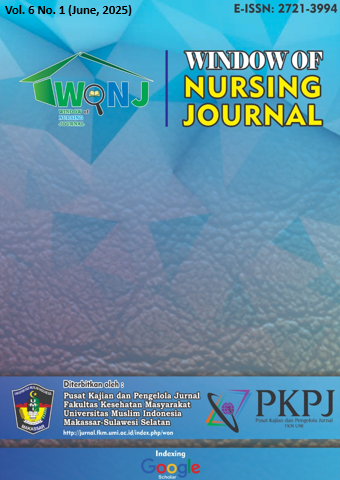Kejadian Stunting pada Anak Usia Balita
DOI:
https://doi.org/10.33096/n9csgr96Keywords:
Stunting, toddler, exclusive breastfeeding, LBWAbstract
Stunting (short) according to WHO in 2020 is a growth disorder in children caused by chronic malnutrition or chronic infectious diseases as indicated by the z-score value of height for age. This study aims to determine the factors associated with the incidence of stunting in children under five at the Kassi-Kassi Makassar Health Center. This research is a quantitative study using a cross-sectional approach in the nursing program at the Indonesian Muslim University. The population of this study was 154 people and the sample was taken using the total sampling method. The tests in this study were chi square analysis with the level of food (ρ > 0.05). The results of the study showed that there was a relationship between a history of exclusive breastfeeding and the incidence of stunting in children under five at the Kassi-Kassi Makassar Health Center, as shown by the results of statistical tests. There is a relationship between the history of low birth weight LBW babies and the incidence of stunting in children under five at the Kassi-Kassi Makassar Health Center. There is a relationship between the provision of complementary feeding to the incidence of stunting in children under five at the Kassi-Kassi Makassar Health Center as shown by the results of statistical tests.
References
1 Kemenkes, “Stunting,” Kementrian, 2021. https://stunting.go.id/angka-prevalensi-stunting-tahun-2020-diprediksi-turun/.
2 K. P. P. N. (Bappenas) dan United and N. C. F. (UNICEF), Laporan Baseline SDG Tentang Anak-anak di Indonesia. Jakarta: Bappenas dan Unicef, 2017.
3 K. K. RI, “Penanganan Stunting Terpadu Tahun 2018,” Kementrian Keuangan, 2018. http://www.anggaran.depkeu.go.id/content/Publikasi/%0Astunting/Penanganan Stunting_DJA.pdf.
4 TNP2K, 100 Kabupaten/Kota Prioritas untuk Intervensi Anak Kerdil (Stunting). 1st ed. Jakarta: Sekretariat Wakil Presiden Republik Indonesia, 2017.
5 R. Kemenkes, Profil Kesehatan Indonesia Tahun 2018. Jakarta: Kementerian Kesehatan Republik Indonesia, 2019.
6 UNICEF, LEVELS AND TRENDS IN CHILD MALNUTRITION. Jakarta: UNICEF Indonesia, 2020.
7 S. G. Henningham, H. B. & McGregor, Gizi dan perkembangan anak. In Gibney, M. J. dkk (Eds.), Gizi kesehatan masyarakat. Jakarta: Buku Kedokteran ECG, 2015.
8 A. Sr and S. A. Sampe, “Hubungan Pemberian ASI Eksklusif Dengan Kejadian Stunting Pada Balita Relationship between Exclusive Breastfeeding and Stunting in Toddlers,” Juni, vol. 11, no. 1, pp. 448–455, 2020, doi: 10.35816/jiskh.v10i2.314.
9 A. Rahayu, F. Yulidasari, A. O. Putri, and F. Rahman, “Birth Weight Records with Stunting Incidence among Children under Two Years Old,” J. Kesehat. Masy. Nas., vol. 10, no. 2, pp. 67–73, 2015.
10 E. Diaz, Y., Lusmilasari, L., & Madyaningrum, “Fenomena Perilaku Makan Toddler dan Hubungannya dengan Perilaku Pemberian Makan Orang Tua,” Journals Ners Community, vol. 8, pp. 159–171, 2017.
11 L. dan S. W. Nababan, “Pemberian MPASI dini pada bayi ditinjau dari pendidikan dan pengetahuan ibu Early Breastfeeding Supplemental Food In Baby Viewed From Maternal Education and Knowledge,” J. Keperawatan dan Kebidanan Aisyiyah, vol. 14, no. 1, pp. 32–39, 2018, [Online]. Available: http://dx.doi.org/10.31101/jkk.547.
12 S. E. Prilyastuty, “Faktor – Faktor Yang Berhubungan Dengan Pemberian Mp-Asi Dini Pada Bayi Usia 6-11 Bulan,” J. Kebidanan, 2020, [Online]. Available: http://digilib.unisayogya.ac.id/id/eprint/5886.
13 R. D. Amanda, “Hubungan pemberian MP-ASI dan tingkat pendidikan terhadap kejadian stunting pada balita: literature review,” J. Penelit. Perawat Prof., vol. 3, no. 2, pp. 407–412, 2021.













